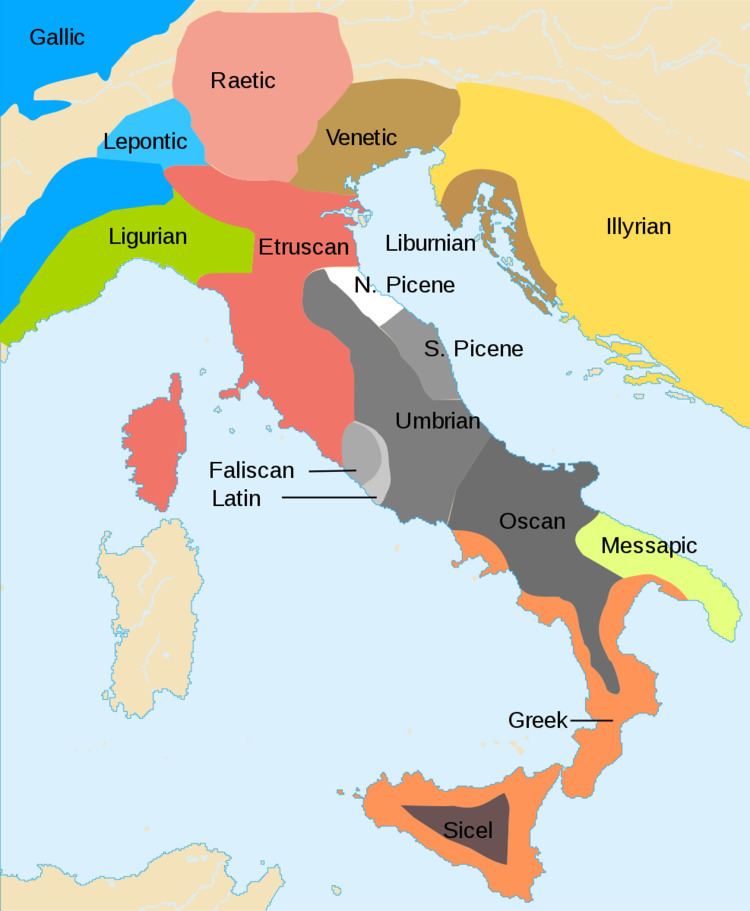Glottolog vene1257 | ||
 | ||
Era attested 5th–1st century BC Language family Indo-EuropeanItalic?Venetic | ||
Venetic is an extinct Indo-European language, usually classified into the Italic subgroup, that was spoken in ancient times in the North East of Italy (Veneto) and part of modern Slovenia, between the Po River delta and the southern fringe of the Alps.
Contents
The language is attested by over 300 short inscriptions dating from the 6th to the 1st century BC. Its speakers are identified with the ancient people called Veneti by the Romans and Enetoi by the Greeks. It became extinct around the 1st century when the local inhabitants were assimilated into the Roman sphere. Inscriptions dedicating offerings to Reitia are one of the chief sources of knowledge of the Venetic language.
Venetic should not be confused with Venetian, a Romance language presently spoken in the same general region, which developed from Vulgar Latin, another Italic language.
Linguistic classification
Venetic is a centum language. The inscriptions use a variety of the Northern Italic alphabet, similar to the Etruscan alphabet.
The exact relationship of Venetic to other Indo-European languages is still being investigated, but the majority of scholars agree that Venetic, aside from Liburnian, shared some similarities with the Italic languages and so is sometimes classified as Italic. However, since it also shared similarities with other Western Indo-European branches (particularly Celtic languages and Germanic languages), some linguists prefer to consider it an independent Indo-European language. Venetic may also have been related to the Illyrian languages once spoken in the western Balkans, though the theory that Illyrian and Venetic were closely related is debated by current scholarship.
Some important parallels with the Germanic languages have also been noted, especially in pronominal forms:
Venetic: ego = I, accusative mego = meGothic: ik, accusative mik(Latin: ego, accusative me)Venetic: sselboi sselboi = to oneselfOld High German: selb selbo(Latin: sibi ipsi)A recent research found out that Venetic was a relatively archaic language significantly similar to Celtic, on the basis of morphology, while it occupied an intermediate position between Celtic and Italic, on the phonological side, but the similarities with the latter may well have arisen as areal phenomena. Phonological similarities to Rhaetian have also been pointed out.
Features
Venetic had about six or even seven noun cases and four conjugations (similar to Latin). About 60 words are known, but some were borrowed from Latin (liber.tos. < libertus) or Etruscan. Many of them show a clear Indo-European origin, such as vhraterei < PIE *bhraterei = to the brother.
Phonology
In Venetic, PIE stops *bʰ, *dʰ and *gʰ developed to /f/, /f/ and /h/, respectively, in word-initial position (as in Latin and Osco-Umbrian), but to /b/, /d/ and /g/, respectively, in word-internal intervowel position (as in Latin). For Venetic, at least the developments of *bʰ and *dʰ are clearly attested. Faliscan and Osco-Umbrian have /f/, /f/ and /h/ internally as well.
There are also indications of the developments of PIE *kʷ > kv, *gʷ- > w- and PIE *gʷʰ- > f- in Venetic, the latter two being parallel to Latin; as well as the regressive assimilation of the PIE sequence *p...kʷ... > *kʷ...kʷ..., a feature also found in Italic and Celtic.
Language sample
A sample inscription in Venetic, found on a bronze nail at Este (Es 45):
Venetic: Mego donasto śainatei Reitiiai porai Egeotora Aimoi ke louderobosLatin (literal): me donavit sanatrici Reitiae bonae Egetora [pro] Aemo liberis-queEnglish: Egetora gave me to Good Reitia the Healer on behalf of Aemus and the childrenAnother inscription, found on a situla (vessel such as an urn or bucket) at Cadore (Ca 4 Valle):
Venetic: eik Goltanos doto louderai KaneiLatin (literal): hoc Goltanus dedit liberae CaniEnglish: Goltanus sacrificed this for the virgin KanisScholarship
The most prominent scholars who have deciphered Venetic inscriptions or otherwise contributed to the knowledge of the Venetic language are Carl Eugen Pauli, Hans Krahe, Giovanni Battista Pellegrini, Aldo Luigi Prosdocimi, and Michel Lejeune. Recent contributors include Loredana Calzavara Capuis and Anna Maria Chieco Bianchi.
